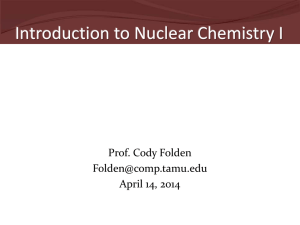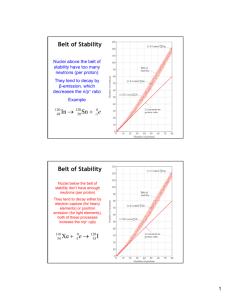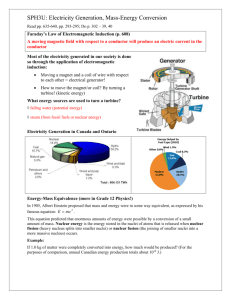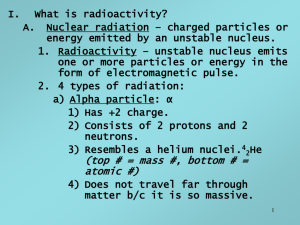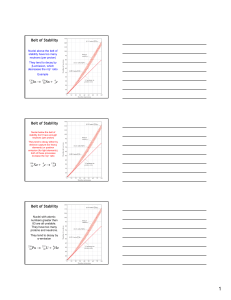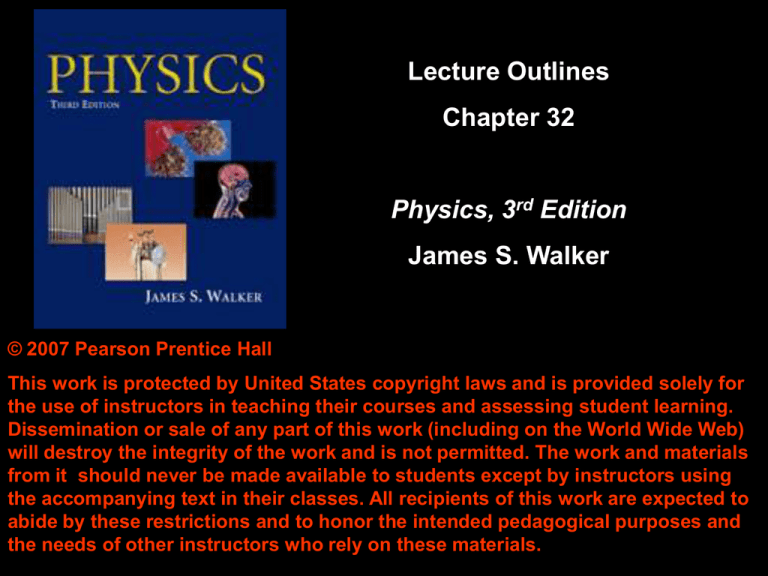
Lecture Outlines
Chapter 32
Physics, 3rd Edition
James S. Walker
© 2007 Pearson Prentice Hall
This work is protected by United States copyright laws and is provided solely for
the use of instructors in teaching their courses and assessing student learning.
Dissemination or sale of any part of this work (including on the World Wide Web)
will destroy the integrity of the work and is not permitted. The work and materials
from it should never be made available to students except by instructors using
the accompanying text in their classes. All recipients of this work are expected to
abide by these restrictions and to honor the intended pedagogical purposes and
the needs of other instructors who rely on these materials.
Chapter 32
Nuclear Physics and
Nuclear Radiation
Units of Chapter 32
• The Constituents and Structure of Nuclei
• Radioactivity
• Half-Life and Radioactive Dating
• Nuclear Binding Energy
• Nuclear Fission
• Nuclear Fusion
• Practical Applications of Nuclear Physics
Units of Chapter 32
• Elementary Particles
• Unified Forces and Cosmology
32-1 The Constituents and Structure of
Nuclei
Nuclei contain positively charged protons and
neutral neutrons. Nuclei are characterized by the
number of protons and neutrons they contain.
32-1 The Constituents and Structure of
Nuclei
The notation for a particular nucleus of
element X is written:
Examples:
Masses and charges of atomic particles:
32-1 The Constituents and Structure of
Nuclei
The atomic mass unit, u, is defined so that the
mass of
is exactly 12 u.
This mass may also be written in terms of
MeV/c2, using E = mc2:
32-1 The Constituents and Structure of
Nuclei
Careful measurements have related the size of
the nucleus to its atomic number:
By contrast, the radius of an atom is on the
order of 10-10 m. This means that the density
of the nucleus is extremely high.
For convenience, we define:
32-1 The Constituents and Structure of
Nuclei
If the nucleus contains only positive charges, why
doesn’t it fly apart due to their mutual repulsion?
There is another force acting, called the strong
nuclear force, which keeps it together. Its
properties:
• The strong force is short range, acting only to
distances of a couple fermis.
• The strong force is attractive and acts with
nearly equal strength between protons and
protons, protons and neutrons, and neutrons and
neutrons.
32-1 The
Constituents and
Structure of Nuclei
Since the strong
nuclear force is short
range, atoms with
more protons must
have proportionally
more neutrons in order
to remain stable.
32-2 Radioactivity
Unstable nuclei can either decay into a stable
nucleus of different N and Z, or can return to
the ground state. Three different types of
particles may be emitted:
1. Alpha particles, which consist of two neutrons
and two protons, and are nuclei of
2. Electrons and positrons, also called (for
historical reasons) beta rays. Positrons have
the same mass as electrons but are positively
charged.
3. Gamma rays, which are high-energy photons.
32-2 Radioactivity
Penetrating abilities:
• α rays can barely penetrate a sheet of paper.
• β rays (both β- and β+) can penetrate a few
millimeters of aluminum.
• γ rays can penetrate several centimeters of
lead.
32-2 Radioactivity
When a nucleus decays by emitting an alpha
particle, it loses two protons and two neutrons,
Symbolically:
Here, X is the parent nucleus
and Y is the daughter.
32-2 Radioactivity
The basic process in beta decay converts a
neutron into a proton and an electron:
Therefore, a nucleus that decays via beta
decay loses a neutron and gains a proton.
If a nucleus emits a positron, a proton has
become a neutron:
32-2 Radioactivity
Analysis of the energy spectrum of the emitted
electron in beta decay showed that it was not
monoenergetic, as would be expected from a
two-body decay.
32-2 Radioactivity
In fact, there is a third particle emitted, which
has no electric charge and little, if any, mass,
called the neutrino. With the neutrino, beta
decay is more correctly written:
32-2 Radioactivity
A gamma ray is emitted when an excited
nucleus returns to its ground state. Nuclei may
become excited through alpha or beta decay,
leading to a sequence such as this one:
The asterisk indicates the excited nucleus.
32-2 Radioactivity
Heavy nuclei decaying via alpha emission may
very well decay to a daughter nucleus which is
also unstable, and so on. The decays will
continue until a stable nucleus is reached.
For example, one isotope of uranium,
,
goes through a decay series that finally ends
up at a stable isotope of lead,
.
32-2 Radioactivity
This is a diagram of the series of alpha and beta
decays in the decay chain.
32-2 Radioactivity
Some nuclei decay more rapidly than others. The
rate of decay – the number of decays per second
– is called the activity.
Two units of activity:
The curie (and the millicurie and microcurie)
are most commonly used.
32-3 Half-Life and Radioactive Dating
Nuclear decay is a random process, in that we
do not know which nucleus will decay at what
time. However, if we have a large number of
similar nuclei, we can predict the rate at which
they decay quite well.
The number that decay within a given time
interval is always the same fraction of the total
number at the beginning of the interval; this is
exponential decay.
32-3 Half-Life and Radioactive Dating
Different nuclei have different decay constants λ.
A larger decay constant means the material
decays away more rapidly.
32-3 Half-Life and Radioactive Dating
Nuclear decay can also be characterized by the
half-life, which is the time it takes for half a
sample to decay away.
The half-life is related to the decay constant:
The decay rate, or activity, is also related to
the decay constant:
32-3 Half-Life and Radioactive Dating
The activity as a function of time:
This change in activity can be used in carbon-14
dating of organic materials.
In the Earth’s atmosphere, carbon-12 and
carbon-14 are in equilibrium; as the carbon-14
decays away, more is formed. It is in equilibrium
within living plants and animals as well, as there
is a constant exchange of carbon with the
atmosphere.
32-3 Half-Life and Radioactive Dating
However, at death, this exchange stops, and the
carbon-14 decays without being replenished, with
a half-life of 5730 years.
We can use this to date the material, as we know
the ratio of carbon-12 to carbon-14 in the
atmosphere and therefore the activity of 1 gram of
natural carbon. If we compare that with the present
activity of a sample, we know how old it is.
This technique only works for a few half-lives; after
that the activity is too low to measure reliably.
32-3 Half-Life and Radioactive Dating
This plot shows the activity
of carbon-14 as time passes.
32-4 Nuclear Binding Energy
The mass of any stable nucleus is less than the
sum of the masses of the protons and neutrons
it contains. This difference, multiplied by c2, is
called the binding energy, and is another
consequence of relativity.
32-4 Nuclear Binding Energy
The curve of binding energy is the binding
energy per nucleon:
32-5 Nuclear Fission
Nuclear fission occurs
when a heavy nucleus
splits into two lighter ones,
especially after capturing a
neutron.
The lighter nuclei do not
need so many neutrons, so
there are typically extra
neutrons emitted from the
reaction.
32-5 Nuclear Fission
This emission of multiple neutrons can lead to a
chain reaction, either controlled or uncontrolled.
32-6 Nuclear Fusion
Very light nuclei can combine to form a heavier
nucleus with greater binding energy; energy is
therefore released. This can only occur at
extremely high temperatures, as the nuclei
must be moving fast enough to overcome the
electrical repulsion.
Such temperatures are available in the center
of the Sun and other stars; nuclear fusion is
what powers them.
32-6 Nuclear Fusion
The nuclear fusion process in the Sun begins
with two protons fusing to form deuterium, and
then fusing with a third proton to form helium-3.
After that, a helium-4 nucleus is formed in
one of the following two ways:
Considerable energy is emitted in this
interaction.
32-7 Practical Applications of Nuclear
Physics
Nuclear radiation can be beneficial if used
properly, but can also cause tissue damage.
There are different ways of measuring this
damage.
The first is by measuring the amount of
ionization; the roentgen is the dosage that
creates 2.58 x 10-4 C when passing through 1 kg
of matter.
32-7 Practical Applications of Nuclear
Physics
Another measure is the amount of energy
absorbed by the irradiated material:
However, the same amount of energy of
different types of radiation can have different
biological effects.
32-7 Practical Applications of Nuclear
Physics
In order to quantify these differences, we
define the relative biological effectiveness:
32-7 Practical Applications of Nuclear
Physics
The RBE for different types of radiation:
32-7 Practical Applications of Nuclear
Physics
This can be combined with the dose to give
the biologically equivalent dose, measured in
rem (roentgen equivalent in man).
32-7 Practical Applications of Nuclear
Physics
We receive some
radiation from
natural and
manufactured
sources every
year.
32-7 Practical Applications of Nuclear
Physics
There are a number of medical applications for
radioactivity:
• Radioactive tracers are useful in diagnoses
• PET scans (positron-emission tomography)
are useful in looking at the brain, including
normal activity, abnormalities, and tumors
• Magnetic resonance imaging (MRI) is
particularly good at imaging soft tissue
32-8 Elementary Particles
All forces of nature are manifestations of just
four fundamental forces:
The only one we have not discussed so far is the
weak force; it is the one responsible for beta
decay.
32-8 Elementary Particles
There are two kinds of fundamental particles,
leptons and hadrons. Leptons interact only via
the electromagnetic force (if charged) and the
weak force. These are the known leptons:
32-8 Elementary Particles
Hadrons are particles that interact strongly. They
come in two varieties, baryons and mesons.
Protons and neutrons are baryons.
32-8 Elementary Particles
Mesons are created by cosmic rays and in
particle accelerators.
Leptons appear to have no internal structure. The
same is not true of hadrons, however.
32-8 Elementary Particles
It is now known that hadrons are made of
pointlike particles called quarks. A meson is a
quark plus an antiquark; a baryon is three
quarks.
32-8 Elementary Particles
These are the known quarks and antiquarks:
Quarks cannot exist on their own; they are
always found as bound states, either baryons or
mesons.
32-9 Unified Forces and Cosmology
Shortly after the Big Bang, the energy density of
the universe was enormous. All four forces had
the same strength, and comprised a single
unified force. As the universe expanded and the
energy density dropped, the forces “froze out”
one by one, until we have the four forces we are
familiar with today.
32-9 Unified Forces and Cosmology
This diagram illustrates the transitions since
the Big Bang. Exactly how the gravitational
force unifies with the other three is not well
understood.
Summary of Chapter 32
• Nuclei are composed of protons and neutrons
(nucleons).
• Number of protons in a nucleus (atomic
number): Z
• Number of neutrons in a nucleus: N
• Mass number A = N + Z
• Designation:
• Isotopes: same atomic number, different N
Summary of Chapter 32
• Mass of
is exactly 12 u.
•
• Nuclear radius:
• Nuclear density is approximately constant
• Strong nuclear force holds nuclei together
• Radioactivity is the emission from the decay of
an unstable or excited nucleus
Summary of Chapter 32
• An alpha particle (helium nucleus) is two
protons and two neutrons.
• Alpha decay:
• Beta decay:
• Gamma decay occurs when an excited nucleus
decays to its ground state.
• Activity is the number of decays per second:
Summary of Chapter 32
• Nuclear decay:
• Half-life related to decay constant:
• Decay rate:
Summary of Chapter 32
• The binding energy of a nucleus is the energy
that must be supplied to separate it into its
component nucleons.
• Nuclear fission is the splitting of a heavier
nucleus into two or more lighter ones, plus extra
neutrons.
• These extra neutrons can cause a chain
reaction.
• Nuclear fusion occurs when two light nuclei
join to make a single heavier one.
Summary of Chapter 32
• There are several ways of measuring radiation
dose.
• Ionization charge:
• Energy deposit:
• Relative biological effectiveness:
Summary of Chapter 32
• Biological dose:
• There are four fundamental forces in nature:
strong nuclear force, electromagnetic force,
weak nuclear force, and gravity
• Leptons interact only electromagnetically and
weakly
• Hadrons interact strongly
• Hadrons consist of quarks, either a quarkantiquark pair or three quarks
• The fundamental forces were unified at the
time of the Big Bang


